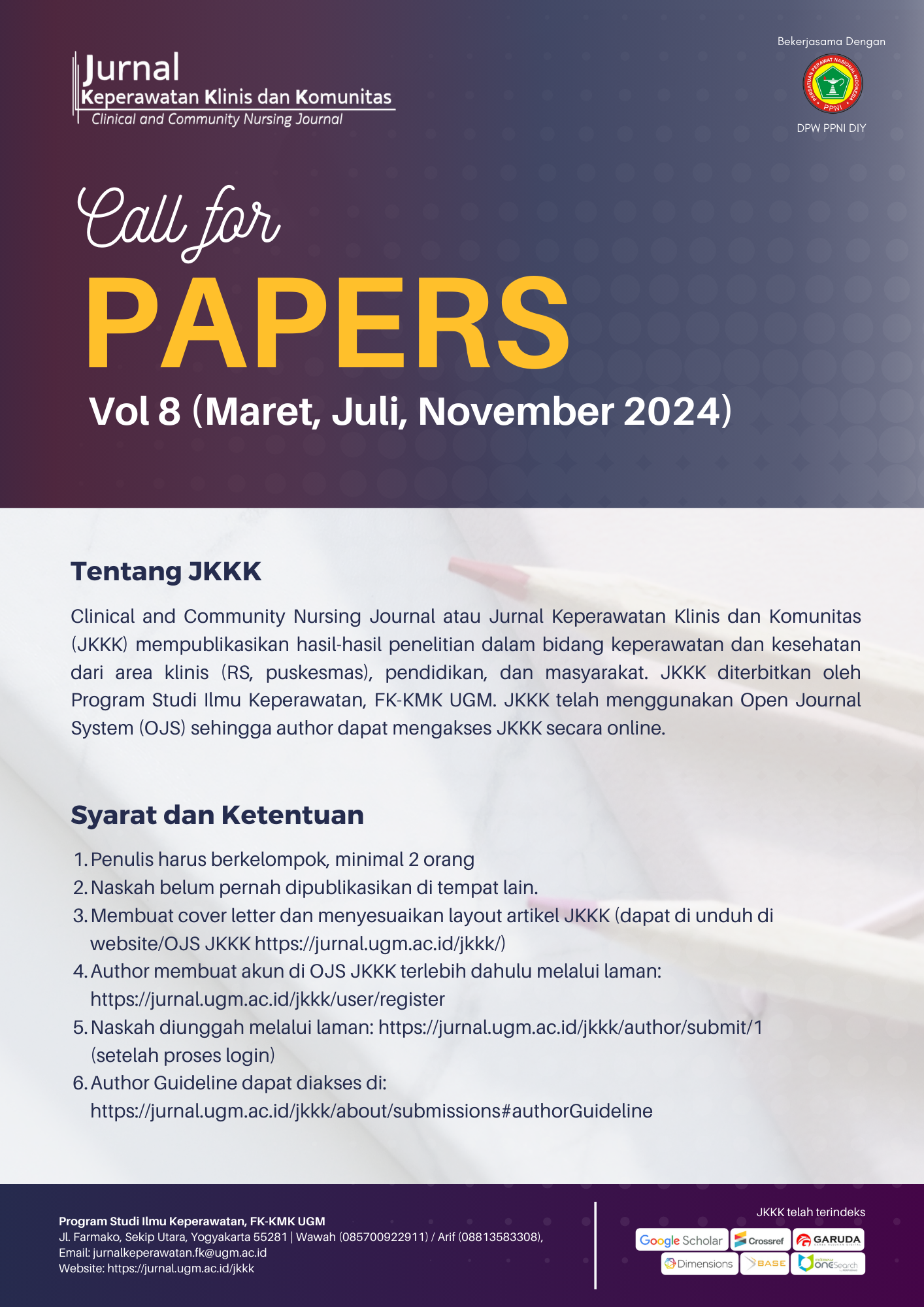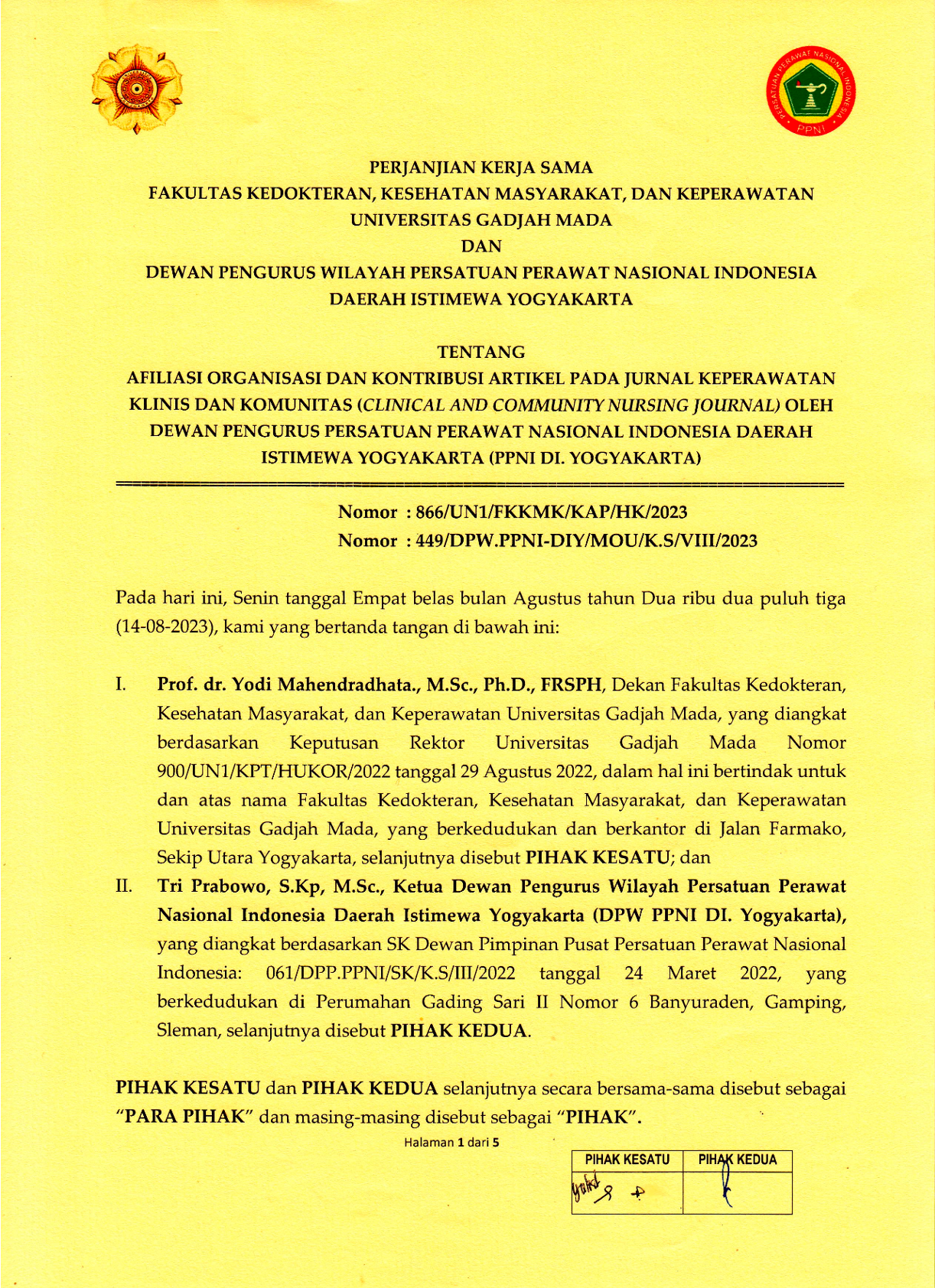Efektivitas Biaya Program Berbasis Keperawatan: Pemasangan Akses Vena Sentral Melalui Perifer Yang Dipandu Ultrasonografi
Anastasia Sari Kusumawati(1*), Sukihananto Sukihananto(2)
(1) RSUD Kota Yogyakarta
(2) Departemen Keperawatan Komunitas, Fakultas Ilmu Keperawatan, Universitas Indonesia
(*) Corresponding Author
Abstract
Background: Vein access is frequent procedures in hospital care. Repeated attempts to cannulate small veins can cause considerable distress for patients and took considerable amount of staff's time. Peripherally inserted central catheter recommended replacing a long term peripheral catheter. The responsibility for the insertion of peripheral catheters has shifted from specially trained nurses to skilled nurses. A peripherally inserted central venous catheter is recommended to replace long term peripherally catheters.
Objective: This literature study goals to give a view in cost effectiveness venous access practices using ultrasound-guided practices and traditional cannulate practices nurse-based.
Method: The method used in this paper is literature review related topics.
Result: There are several studies that demonstrate the cost effectiveness of venous access practices using nursing-based ultrasound guidelines.
Conclusion: Result shows by implementation of nursing based on ultrasound-guided peripheral venous access gave more effective approach than traditional practices.
ABSTRAK
Latar belakang: Akses vena sering dilakukan dalam perawatan di rumah sakit. Upaya berulang untuk memasang kateter vena kecil dapat menyebabkan tekanan mental yang besar bagi pasien dan membutuhkan waktu staf cukup banyak. Tanggung jawab pemasangan kateter perifer telah bergeser dari perawat sangat terampil ke perawat terampil. Pemasangan akses vena sentral melalui perifer direkomendasikan untuk mengganti kateter perifer jangka panjang.
Tujuan: Tinjauan studi literatur ini diharapkan dapat memberi gambaran tentang efektivitas biaya praktik akses vena dengan menggunakan panduan ultrasonografi berbasis keperawatan.
Metode: Metode yang digunakan dalam penulisan ini adalah literature review terkait topik.
Hasil: Terdapat beberapa penelitian yang membuktikan efektivitas biaya praktik akses vena dengan menggunakan panduan ultrasonografi berbasis keperawatan.
Kesimpulan: Hasil menunjukkan bahwa penerapan akses vena perifer dengan panduan ultrasonografi berbasis keperawatan, mampu menjadi pendekatan yang lebih efektif dibandingkan praktik tradisional.
Keywords
Full Text:
PDFReferences
Danski MTR, Oliveira AM, Meier MJ, Pedrolo E. Effectiveness of ultrasonography-guided peripheral venous access : An integrative review. Enferm Glob. 2016;382–95.
Cheung E, Baerlocher MO, Myers A, Myers A. Venous access. Praxis (Bern 1994). 2009;55:494–6.
Barría RM, Lorca P, Muñoz S. Randomized controlled trial of vascular access in newborns in the neonatal intensive care unit. J Obstet Gynecol Neonatal Nurs [Internet]. 2007;36(5):450–6. Available from: http://linkinghub.elsevier.com/retrieve/pii/S0884217515336844
Walker G, Todd A. Nurse-led PICC insertion: Is it cost effective? Br J Nurs. 2015;22(19):9–15.
Gosselin É, Lapré J, Lavoie S, Rhein S. Cost-effectiveness of introducing a nursing-based programme of ultrasound-guided peripheral venous access in a regional teaching hospital. J Nurs Manag. 2017;25(5):339–45.
Bauman M, Braude D, Crandall C. Ultrasound-guidance vs standard technique in difficult vascular access patients by ED technicians. Am J Emerg Med. 2009;27:135–40.
Stokowski G, Steele D, Wilson D. The use of ultrasound to improve practice and reduce complication rates in peripherally inserted central catheter insertions: Final report of investigation. J Infus Nurs Art Sci Infus Nurs. 2009;32(3):145–55.
Adhikari S, Blaivas M, Morrison D, Lander L. Comparison of infection rates among ultrasound-guided versus traditionally placed peripheral intravenous lines. J Ultrasound Med. 2010;29:741–7.
Emergency Nurses Association (ENA) Clinical Practice Guideline Committe. Clinical practice guideline: difficult intravenous access [Internet]. 2nd ed. Des Plaines; 2015. 37 p. Available from: http://www.ncbi.nlm.nih.gov/books/NBK12155/
Melanie Crowley, Carla Brin, Jean Proehl, Susan Barnason, Sherry Leviner, Cathleen Lindauer, Mary Naccarato, Andrew Storer JW. Clinical practice guideline: Difficult intravenous access full version. Emergency Nurses Association. 2013. 1-15 p.
Calvert N, Hind D, McWilliams R, Thomas S, Beverley C, Davidson A. The effectiveness and cost-effectiveness of ultrasound locating devices for central venous access: A systematic review and economic evaluation. Vol. 7, Health Technol Assess. 2003.
Calvert N., Hind D, McWilliams R, Davidson A, Beverley CA, Thomas SM. Ultrasound for central venous cannulation: Economic evaluation of cost-effectiveness. Anaesthesia. 2004;59(11):1116–20.
Robinson MK, Mogensen KM, Grudinskas GF, Kohler S, Jacobs DO. Improved care and reduced costs for patients requiring peripherally inserted central catheters: The role of bedside ultrasound and a dedicated team. JPEN J Parenter Enter Nutr. 2005;29(5):374–9.
Johnson MA, McKenzie L, Tussey S, Jacobs H, Couch C. Portable ultrasound: A cost-effective process improvement tool for PICC placement. Nurs Manage. 2009;(January):47–50.
White A, Lopez F, Stone P. Developing and sustaining an ultrasound-guided peripheral intravenous access program for emergency nurses. Adv Emerg Nurs J. 2010;32(2):173–88.
Dolister M, Miller S, Borron S, Truemper E, Shah M, Lanford MR, et al. Intraosseous vascular access is safe, effective and costs less than central venous catheters for patients in the hospital setting. J Vasc Access [Internet]. 2013;14(3):216–24. Available from: http://www.vascular-access.info/article/intraosseous-vascular-access-is-safe--effective-and-costs-less-than-central-venous-catheters-for-patients-in-the-hospital-setting
Setiasih Y, Fatimah S, Fitri SYR. Peripherally inserted central catheter dan pemberian terapi intravena pada neonatus. J Keperawaan Padjadjaran. 2013;1:1–7.
Hadaway L. Short peripheral intravenous catheters and infections. J Infus Nurs Art Sci Infus Nurs [Internet]. 2012; 35(4):230–40. Available from: http://content.wkhealth.com/linkback/openurl?sid=WKPTLP:landingpage&an=00129804-201207000-00007
Fallouh N, MnGuirk HM, Flanders SA, Chopra V. Peripherally inserted central catheter-associated deep vein thrombosis: A narrative review. Am J Med [Internet]. 2015;34(4):159–64. Available from: http://dx.doi.org/10.1016/j.amjmed.2015.01.027
Winters JP, Callas PW, Cushman M, Repp AB, Zakai NA. Central venous catheters and upper extremity deep vein thrombosis in medical inpatients: The Medical Inpatients and Thrombosis (MITH) Study. J Thromb Haemost. 2015;13(12):2155–60.
Johansson E, Hammarskjöld F, Lundberg D, Arnlind MH. Advantages and disadvantages of peripherally inserted central venous catheters (PICC) compared to other central venous lines: A systematic review of the literature. Acta Oncol [Internet]. 2013;52(5):886–92. Available from: http://www.ncbi.nlm.nih.gov/pubmed/23472835
Nolan ME, Yadav H, Cawcutt KA, Cartin-Ceba R. Complication rates among peripherally inserted central venous catheters and centrally inserted central catheters in the medical intensive care unit. J Crit Care [Internet]. 2016;31(1):238–42. Available from: http://dx.doi.org/10.1016/j.jcrc.2015.09.024
Deutsch GB, Sathyanarayana SA, Singh N, Nicastro J. Ultrasound-guided placement of midline catheters in the surgical intensive care unit: A cost-effective proposal for timely central line removal. J Surg Res [Internet]. 2014;191(1):1–5. Available from: http://dx.doi.org/10.1016/j.jss.2013.03.047
Osborn SR, Borhart J, Antonis MS. Medical students benefit from the use of ultrasound when learning peripheral IV techniques. Crit Ultrasound J. 2012;4(1):2.
Oliveira L, Lawrence M. Ultrasound-guided peripheral intravenous access program for emergency physicians, nurses, and corpsmen (technicians) at a military hospital. Mil Med [Internet]. 2016;181(3):272–6. Available from: http://www.ncbi.nlm.nih.gov/pubmed/26926753
Morrow DS, Broder J. Cost-effective, reusable, leak-resistant ultrasound-guided vascular access trainer. J Emerg Med [Internet]. 2014;49(3):313–7. Available from: http://dx.doi.org/10.1016/j.jemermed.2015.04.005
Article Metrics
Refbacks
- There are currently no refbacks.
Copyright (c) 2017 Anastasia Sari Kusumawati, Sukihananto

Jurnal Keperawatan Klinis dan Komunitas (Clinical and Community Nursing Journal)
collaborates with DPW PPNI DIY
![]()
Jurnal Keperawatan Klinis dan Komunitas (Clinical and Community Nursing Journal) is licensed under a Creative Commons Attribution-ShareAlike 4.0 International License.





